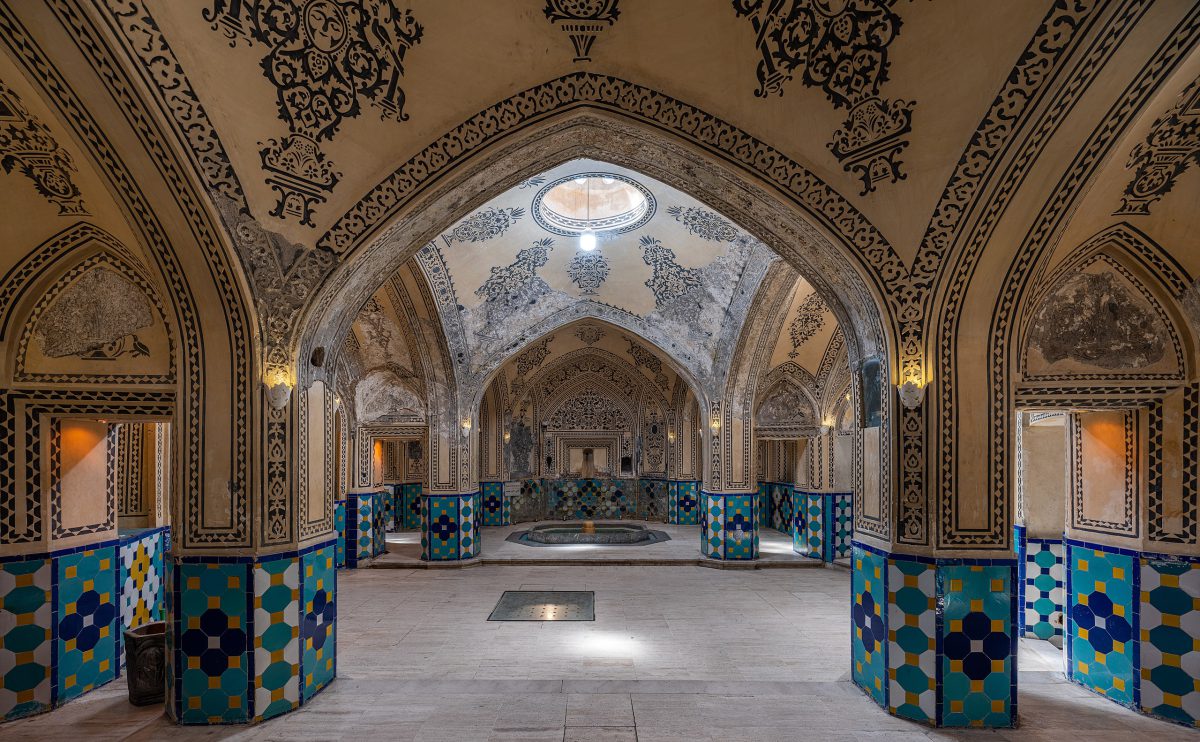Table of Contents
If you’re looking for a unique experience in Iran, you won’t want to miss the Sultan Amir Ahmad bath. This beautiful attraction is located right in the heart of the city of Kashan, Isfahan Province, surrounded by plenty of restaurants, cafes, and eateries. You’ll easily find a traditional residence that offers a taste of Iranian architecture and the chance to stay in historic buildings from the Qajar and Pahlavi periods. Trust me, it’s an experience you won’t forget!
The historic district of Kashan dates back to the Seljuk, Safavid, and Qajar periods. During these periods, Iranian cities featured essential elements such as mosques, bazaars, houses, baths, and water storage. As a result, Sultan Amir Ahmad Bath in Kashan holds significant importance as an urban center.
In this article, we aim to shed light on the history and importance of Hammam, also known as the public bathhouse, in Iran. We will dive into its cultural evolution and traditional practices, while also exploring the spa treatments that took place in ancient Persia and the impact it has had on modern spa culture. Additionally, we will provide you with a list of the best-recommended restaurants, accommodations, and attractions to experience during your trip to Iran.
Hammam in Iran
The tradition of hammams in Iran dates back to ancient times, with historical evidence of their existence during the Achaemenid Empire (550–330 BCE). These sanctuaries have played a pivotal role in Iranian culture, serving not only as cleansing spots but also as venues for relaxation and social interaction.
Over the centuries, the culture of hammams in Iran has evolved, shaped by the influences of different dynastic eras. Persian hammams have been profoundly influenced by Islamic art and architecture, resulting in breathtaking tilework and intricate designs that adorn these spaces.
When entering a traditional Iranian hammam, visitors embark on a journey that typically starts with a warm-up room, followed by a series of hot and cold baths, steam rooms, and rejuvenating massages. The ritual often includes scrubbing and exfoliation using special gloves known as “Kiseh.”
Spa in Ancient Persia
Ancient Persia boasted an array of spa treatments, offering massages with aromatic oils, herbal baths, and soothing steam baths. Royalty in Persia indulged in lavish treatments, such as rosewater baths and saffron-infused oils.
What sets Persian spa culture apart is its emphasis on natural ingredients like herbs and minerals. Persian spas are distinguished by their opulent architecture and intricate designs, setting them apart from spa traditions in other ancient civilizations.
For Persian royalty, spa treatments were not merely a means of maintaining physical health; they were also a pathway to relaxation and rejuvenation, reflecting the grandeur of Persian court life. The Persians expertly harnessed the power of nature, utilizing ingredients like rosewater, saffron, and clay for their therapeutic and beautifying properties.
Cultural Significance of Ancient Spa in Persia
The spa culture of ancient Persia has left an enduring legacy on the development of modern spa treatments. Many practices and ingredients from ancient Persia, such as aromatherapy and herbal remedies, continue to be integral components of contemporary spa therapies.
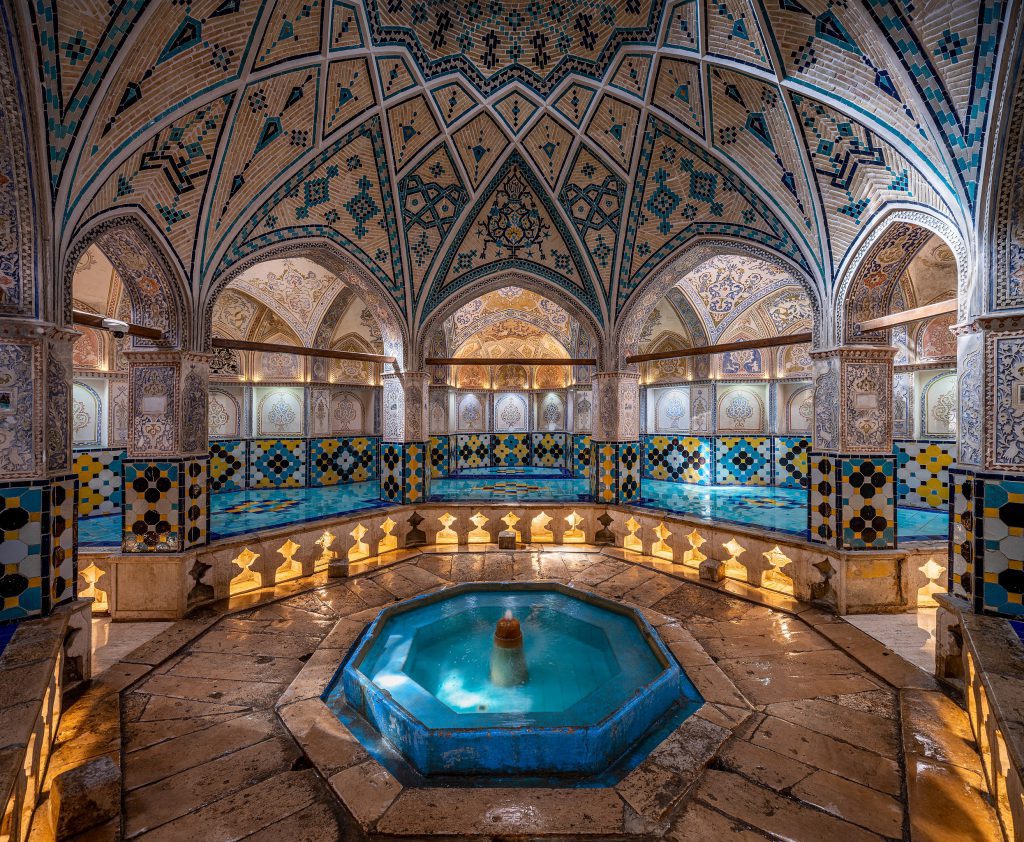
In ancient Persia, the act of bathing and spa rituals held deep significance for both physical and spiritual well-being. These rituals transcended mere hygiene; they were a means of connecting with nature and achieving inner harmony. The soothing ambiance and therapeutic treatments were believed to restore balance to the body and mind.
Throughout Persian history, spa culture evolved, adapting to the changing dynasties and external influences. The importance of spas remained unwavering, with their opulence and beauty profoundly influencing Persian art and literature. These spaces served as muses for poetry, paintings, and architectural designs that celebrated their splendor.
The cultural significance of Persian spas extended beyond Iran’s borders, influencing neighboring civilizations, particularly in the Islamic world. Elements of Persian hammams left their mark across regions, including Central Asia, Mughal India, the Ottoman Empire, and North Africa. This influence encompassed architectural features like domed roofs and intricate tilework, as well as bathing traditions and holistic approaches to well-being. Additionally, elements of Persian hammams found their way into European spa culture during the Renaissance and subsequent periods, contributing to the evolution of European bathhouses.
History of Sultan Amir Ahmad Bathhouse Kashan
The Sultan Amir Ahmad Kashan bathhouse stands as one of Iran’s most exquisite bathhouses, offering a captivating glimpse into the Seljuk and Qajar eras. Recognized as a national monument of Iran, this bathhouse boasts unparalleled architectural beauty and intricate decorations, nestled within a historic neighborhood of Kashan. Nearby, you’ll find a treasure trove of attractions, including the Borujerdi House, Tabatabaei Historical House, and the Abbasi House.
The name of the Sultan Amir Ahmad bathhouse pays homage to the nearby Imamzadeh, the grandson of Imam Javad (a.s.), one of the 12 Shia imams. Evidence and artifacts recovered from this bathhouse after a devastating earthquake in 1771 trace its roots back to the Seljuk era. However, the dressing room, known as “Sarbineh” in old Persian, belongs to the Qajar period. Some historians believe that the bathhouse we see today in Kashan was constructed during the Qajar era in 1875, built upon the ruins of the old bathhouse, with a small addition.
The Architecture of Sultan Amir Ahmad Bathhouse
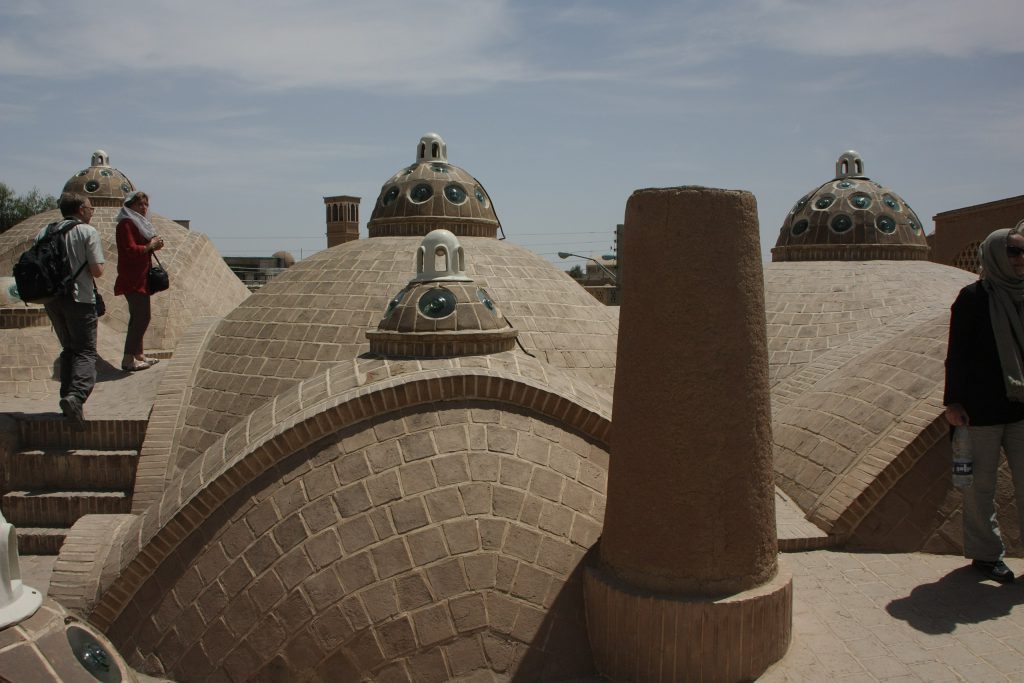
The Sultan Amir Ahmad Bathhouse can be divided into two distinct areas: the large and small bathhouse. In traditional Iranian bathhouses like this one, entering the dressing room, the initial spacious area of the bathhouse, involves traversing several interconnected spaces.
Upon entering the Sultan Amir Ahmad bathhouse, you’ll be greeted by captivating motifs adorning its entrance, including exquisite flower and pigeon designs, as well as statues and paintings depicting city hunting scenes. Beyond the entrance, a traditional Iranian architectural feature called “Hashti,” a connecting corridor between the outside and inside space awaits.
Further exploration leads to winding corridors designed to provide comfort to visitors by gradually acclimating them to changes in air temperature. These corridors eventually lead to the “Sarbineh,” the primary area for preparing for bathing or exiting the bathhouse.
“Sarbineh” was traditionally kept semi-warm to ensure clients didn’t encounter a sudden transition to hot air, whether they were entering or exiting the bath. This space typically boasts the most intricate decorations, with stucco, mosaics, and tiles adorned with glass glazes.
“Sarbineh” in the Sultan Amir Ahmad bathhouse takes the shape of an octagon, providing a spacious environment for various activities. In the past, bathhouses served not only as places for bodily cleansing but also as venues for social gatherings, problem-solving, leisure, conversation, relaxation, and even worship. Consequently, “Sarbineh” is notably expansive, reflecting this multifaceted role.
After “Sarbineh,” visitors encounter another corridor with two 90-degree turns, leading them to the second primary area of the bathhouse known as “Garm Khaneh.” This is the central bathing area, offering a simpler and more straightforward atmosphere compared to “Sarbineh.” It features designated corners for sitting and bathing.
The Sultan Amir Ahmad bathhouse, like many historical bathhouses, includes three private bathing spaces known as “Khazineh,” each equipped with pools of hot water, cold water, and lukewarm water. The nobility had their separate pool for bathing, highlighting the hierarchy that existed in these bathing spaces.
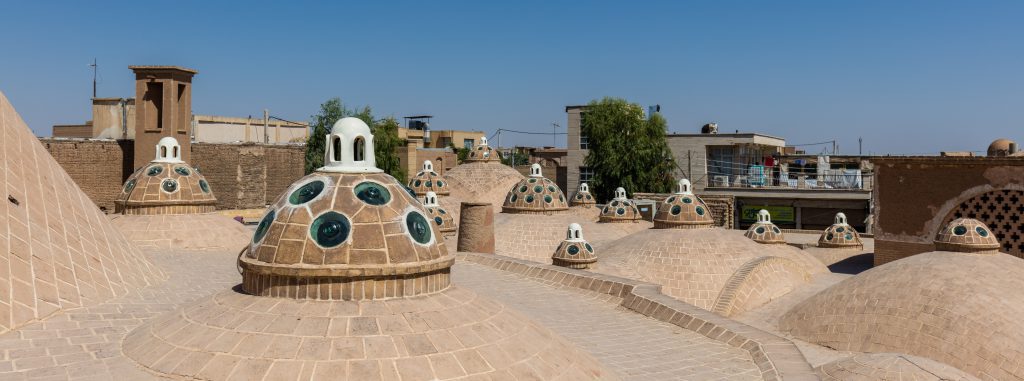
One of the most striking features of the Sultan Amir Ahmad bathhouse is its roof, which boasts an extraordinary domed design. The roof features a series of domes, each fitted with convex lens glass to provide ample natural light to different sections of the bathhouse while maintaining privacy for bathers.
Location of Sultan Amir Ahmad Bathhouse
Sultan Amir Ahmad Bathhouse is conveniently situated at Alavi St., Sultan Amir Ahmad Alley, in the heart of Kashan City, Isfahan Province, Iran.
Its central location makes it easily accessible from various key destinations. If you’re traveling from Tehran, you’ll find the bathhouse approximately 250 km away, which translates to a two-hour and forty-minute journey.
For those exploring the enchanting center of Kashan, you’re just a short eight-minute drive, covering a distance of 4.6 km.
If your journey takes you from Isfahan, Sultan Amir Ahmad Bathhouse is approximately 200 km away, with a travel time of around two hours and ten minutes.
Additionally, if you plan to visit the picturesque Fin Kashan Garden, it’s conveniently located just 11 km (about 16 minutes by car) from this historical and architectural marvel, Sultan Amir Ahmad Bathhouse. Enjoy your travels and exploration of this cultural treasure!
Ticket and Opening Hours of Sultan Amir Spa Iran
To explore the splendid Sultan Amir Ahmad Bathhouse, visitors are required to purchase an entrance ticket, which typically costs approximately 2 euros in 2023. This nominal fee grants you access to a journey through time and culture within the bathhouse’s historic walls. Sultan Amir Ahmad Bathhouse welcomes guests daily from 9 a.m. to 4:30 p.m., providing ample time to immerse yourself in its architectural beauty and rich history.
However, please note that the bathhouse remains closed on mourning days, so it’s advisable to check the schedule in advance when planning your visit to ensure an uninterrupted and enriching experience.
Best Time to Visit Sultan Amir Ahmad Bathhouse Kashan
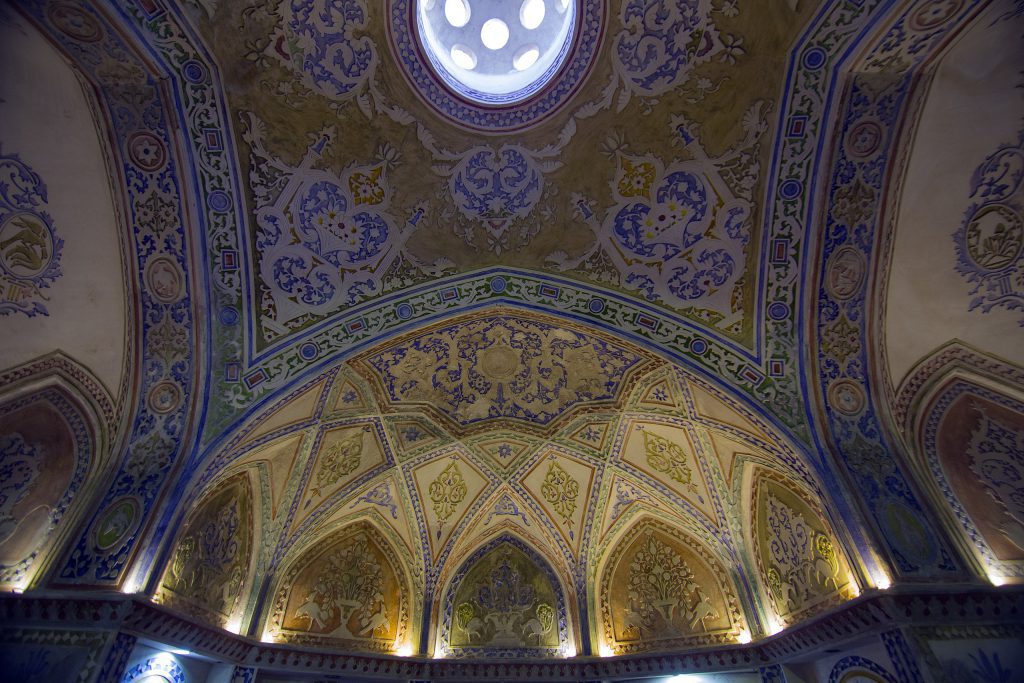
The optimal time to plan your visit to Sultan Amir Ahmad Kashan Bathhouse is from April to June. During this period, Kashan welcomes you with pleasant weather and a vibrant atmosphere, making your exploration of this historical gem even more delightful.
If you wish to coincide your trip with the renowned Rose Water Festival (Golab Giri), a spectacular sight to behold in Kashan, consider traveling during the months of May and June. This unique event, combined with the opportunity to explore the city’s exceptional historical sites, ensures a memorable and culturally enriching experience.
So, mark your calendar for a springtime journey to Sultan Amir Ahmad Bathhouse in Kashan, and immerse yourself in the charm and heritage of this captivating destination.
Where to Eat Near Sultan Amir Ahmad Bathhouse
Discover a wide range of culinary options just a stone’s throw away from Sultan Amir Ahmad Bathhouse. Whether you’re craving traditional Persian dishes, international flavors, or local delicacies, the dining scene in the vicinity has something for everyone. Here’s a list of the best restaurants in this area:
- Ameriano Lounge
- Hall of Mirrors Restaurant
- Cafe Sourchi
- Mozaffari Traditional Restaurant
- Abbasi Traditional Persian Restaurant
- Morshedi Restaurant
Vegetarian Delights in the Heart of Kashan
To our vegetarian friends exploring the enchanting world of Kashan, worry not, for Persian cuisine has some delectable vegetarian options that will tantalize your taste buds. When dining near Sultan Amir Ahmad Bathhouse, be sure to try dishes like “Kashk-e Baadenjaan,” a creamy eggplant dip, and “Zeytoon Parvadeh,” a flavorful olive spread. These savory treats are rich in Persian flavors and free of meat. Additionally, most restaurants in Kashan are incredibly accommodating, and you can always ask for vegetarian versions of traditional dishes. Savor the magic of Persian cuisine while indulging in these delightful vegetarian options and exploring the local culture without any culinary concerns. Your palate is in for a treat!
Best Kashan Hotels Near Sultan Amir Ahmad Bathhouse
Whether you prefer boutique hotels, traditional guesthouses, or modern lodgings, you’ll find a diverse range of accommodation options in the vicinity of Sultan Amir Ahmad Bathhouse.
Experience the rich history of Kashan by staying in beautifully restored historic houses that have been converted into guesthouses. These establishments often feature traditional architecture and provide a unique glimpse into local life.
Here’s a list of the best Boutique Hotels near Sultan Amir Ahmad Bathhouse Kashan:
- Sourijan Boutique Hotel
- Kashan Atlasi Traditional Hotel
- Saraye Ameriha Hotel
- Morshedi House Boutique Hotel
- Saraye Sohrab Sepehri
- Ferdows Kooshk
- Khademi Traditional Hotel
If you’re looking for an eco-friendly resort, Mahboub Eco Lodge is an excellent option. For more information, please call 09197207883.
Embrace Responsible Travel
At To Iran Tour, we’re all about responsible tourism, and here’s why it’s awesome: when you choose eco resorts and eco-lodges near Sultan Amir Ahmad Bathhouse in Kashan, you’re not just booking a place to stay, you’re becoming a hero for the environment. These accommodations respect nature, support local communities, and reduce your ecological footprint. So, when you travel, make it a journey that’s not just about discovery but also about protecting our planet for future explorers. Be a part of something great, be a responsible traveler, and let’s make every trip an adventure with a purpose!
To Iran Tour Team
Attractions Near Sultan Amir Ahmad Bathhouse Kashan
Sultan Amir Ahmad Bathhouse, nestled in the heart of Kashan’s historic context, offers a gateway to an array of captivating attractions that promise to enrich your visit to this cultural gem. With many historical monuments just a short walk away, you’ll find it easy to explore the city’s rich heritage. Journey through time by visiting historic houses like Abbasian Historical House, Taj Historical House, Tabatabaei Historical House, Borujerdi House, Hoseini, and Bani Kazemi Historical House, each with its own unique history and character.
Beyond these architectural marvels, other noteworthy attractions beckon:
- House of Lucie
Delve into the world of photography at the House of Lucie, a cultural complex in Kashan’s historical heart. This renovated Qajar house, with its three courtyards and 30 rooms, showcases the works of photographers who have received the prestigious Lucie Award. The House of Lucie opens its doors from 5 to 9 p.m., making it a perfect choice for a night visit.
- Steve House
Explore the Kashan Photography House, a permanent and free exhibition featuring the remarkable photographs of renowned American photographer Steve McCurry. His iconic portrait of the “Afghan Girl,” often called the “Mona Lisa of the East,” is among the exhibit’s highlights. You can visit the Steve House from 5 to 9 p.m., making it an ideal evening destination.
- Puppet Museum House
Uncover the charm of the Kashan Puppet Museum House, home to a collection of antique dolls, toys, and marionettes dating back to the Qajar era. The museum showcases the oldest marionettes in Iran, local Iranian puppets, as well as international puppetry examples and toys from a century ago. The museum is housed in a complex with seven rooms surrounding a picturesque courtyard.
- Agha Bozorg Mosque
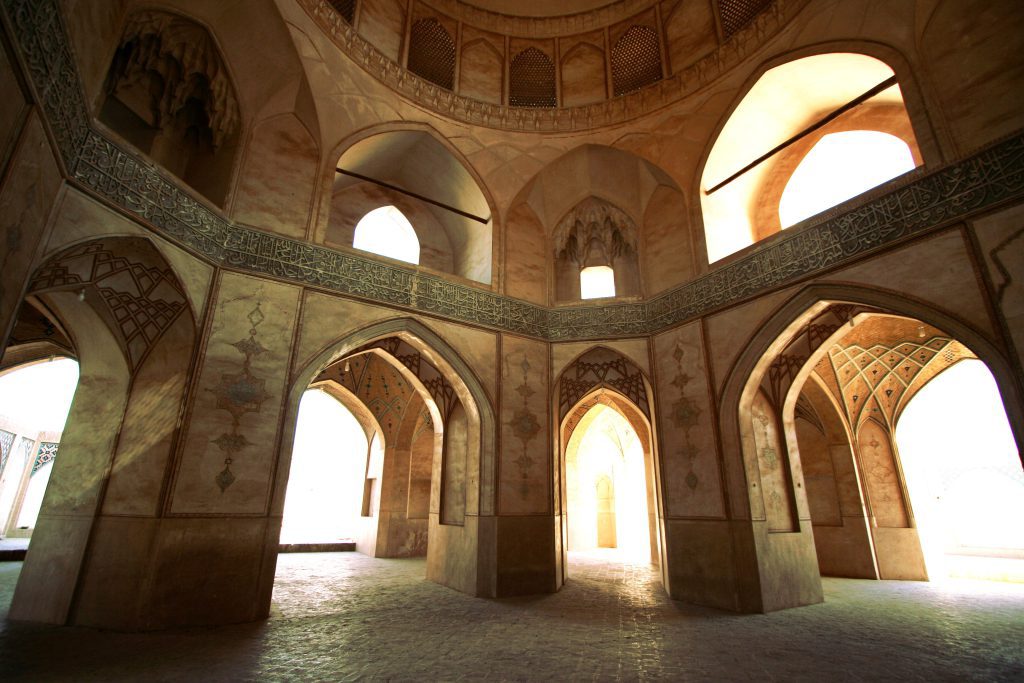
Immerse yourself in the grandeur of Qajar architecture by visiting Agha Bozorg Mosque, a historical masterpiece that encapsulates intricate design and cultural significance. This mosque, part of the Agha Bozorg School, has a rich history dating back to the Qajar era. You can explore this architectural wonder free of charge, with visiting hours from 9 a.m. to 8 p.m. Don’t miss the opportunity to experience the profound beauty and heritage that Kashan has to offer, all within a leisurely stroll from the Sultan Amir Ahmad Bathhouse. We’ve got you covered! We have a whole article about this monument and we’d love to share it with you. Just click on the link below to give it a read:
FAQs About Ancient Spas in Iran
Q1: What is the history of Sultan Amir Ahmad Bathhouse in Iran?
A1: Sultan Amir Ahmad Bathhouse, also known as the Qasemi Bathhouse, is a historical bathhouse located in Kashan, Iran. It dates back to the 16th century and is renowned for its stunning architecture and historical significance.
Q2: How can I get to Sultan Amir Ahmad Bathhouse in Kashan?
A2: To reach Sultan Amir Ahmad Bathhouse in Kashan, you can use various modes of transportation, including private cars, taxis, or public transportation. It’s a popular tourist attraction in the city, so it’s relatively easy to find.
Q3: What are the opening hours of Sultan Amir Ahmad Bathhouse in Iran?
A3: Sultan Amir Ahmad Bathhouse welcomes guests daily from 9 a.m. to 4:30 p.m.
Q4: Is there an entrance fee to visit Sultan Amir Ahmad Bathhouse?
A4: Yes, there is usually an entrance fee to visit Sultan Amir Ahmad Bathhouse. The fee may vary for different groups of visitors, such as tourists and locals. It’s advisable to check the current admission fees before your visit.
Q5: Can I take pictures inside Sultan Amir Ahmad Bathhouse?
A5: Photography policies may vary, but many historical sites in Iran, including Sultan Amir Ahmad Bathhouse, permit photography without the use of flash. However, it’s a good practice to inquire about photography rules on-site.
Q6: Is there a dress code for visiting Sultan Amir Ahmad Bathhouse in Iran?
A6: There is no specific dress code for visiting the bathhouse, but it’s recommended to dress modestly, as is customary in Iran. Wearing comfortable clothing and footwear suitable for walking is advisable.
Embark on Your Iranian Adventure with Us!
If the enchantment of Sultan Amir Ahmad Bathhouse and the rich tapestry of Iranian history and culture have ignited your wanderlust, then it’s time to turn your dreams into reality. At To Iran Tour, we’re not just tour operators; we’re storytellers, and we invite you to be a part of this incredible narrative. Explore the hidden gems, savor the local flavors, and immerse yourself in the vibrant tapestry of Iran with us. Let’s create unforgettable memories, unlock the secrets of ancient civilizations, and celebrate the beauty of responsible travel together. Come and join us on an extraordinary journey through Iran, where each step unveils a new chapter of discovery and wonder. Don’t just imagine it; experience it with To Iran Tour. Your adventure awaits!

